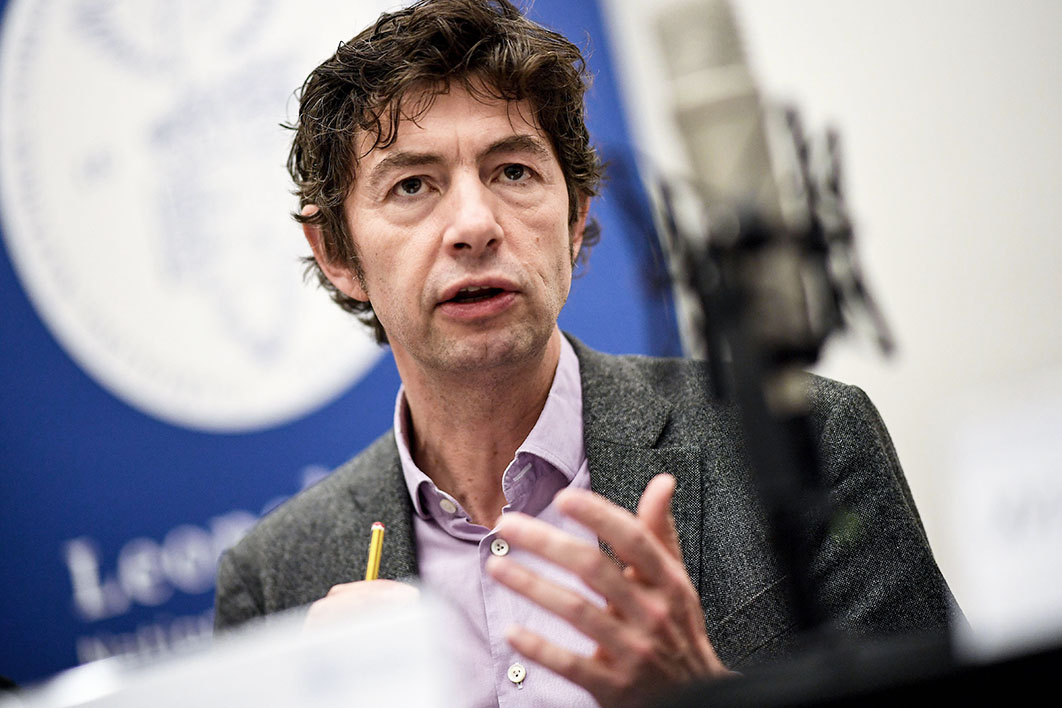Two months ago I wrote the first in what has become a series of Covid-19 articles for Inside Story. Two months before that, the first international alert on the emergence of a new and potentially deadly disease had been published. At history’s critical junctures, the narrative emerges gradually.
For me, the turning point came towards the end of February during a celebration for friends’ birthdays in a vineyard restaurant on a glorious late summer’s day. At the table was a young doctor on his way to specialising in intensive care. He confessed to being obsessed with Covid-19, unusual at the time when it was barely a talking point in Australia. A major metropolitan hospital was making contingency plans to turn over one wing to an isolation ward, he confided. He wondered how people would cope if dire health rationing became necessary.
Since then, we’ve seen an explosion of knowledge. Never before in human history has so much been learnt about a new disease in so short a time. But for all we now know, there is even more that, as yet, we don’t.
We know that since the first identified outbreak in Wuhan, China, around 3.5 million cases have been confirmed. We also know this is an underestimate, as many people are infected but never show symptoms. Until very recently the only people tested have been those with signs of respiratory illness, and in many places testing is hardly available.
We know that 250,000 deaths have been attributed to Covid-19 worldwide, but that this toll is also certainly an underestimate. Cause-of-death statistics are notoriously hard to collect consistently, especially with an emerging or stigmatised disease. Even where health systems have a good handle on hospital deaths, deaths in aged care facilities or at home may not be recorded accurately.
Despite the difficulties attached to attributing mortality and the lack of a precise denominator of the numbers infected with the virus, we do know that the death rate from Covid-19 is substantially worse than from seasonal flu. Australia’s case fatality rate seems to sit around 1.4 per cent, not dissimilar to the rate found in other places — like mainland China, South Korea and Taiwan — where testing has been extensive and the first wave relatively contained. The Diamond Princess has inadvertently provided a closed system to benchmark the fatality rate, with the ratio of deaths per infection coming in at 1.3 per cent, and double that if you count deaths per case of illness. Not surprisingly, a cruise ship population skews old, and Covid-19 has a steep age gradient, so corrections have to be made to estimate potential fatality rates across the whole population.
We know that infections start circulating well before they come to the attention of public health authorities, but nevertheless that physical distancing can strongly curtail epidemic spread. The repertoire of measures includes limiting the numbers of people gathering in close proximity, using face masks to limit the spread of droplets from coughing or sneezing, handwashing with soap to kill the virus on the hands, and disinfection of surfaces. But there is no magic formula or proven combination.
We know that SARS-CoV-2 causes respiratory distress with a complex mechanism of action. “Cytokine storm” is such a resonant metaphor it has become a major window into how the body’s immune system can produce a deadly over-reaction. And, at the molecular level, we are learning how spike proteins on the virus’s surface break into cells and enable its particles to replicate.
We know that the risks of becoming seriously ill with Covid-19 are related to other health conditions, especially diabetes and obesity — though not, surprisingly, to asthma or smoking.
We know that wealth and status are no barriers to infection, but that, once you’re infected, your chances of becoming sick or dying correlate closely to existing patterns of inequality. We also know that new diseases, as they always do, give a boost to long-rehearsed prejudices: the West blaming the East, the South the North, Hindus blaming Muslims, Chinese in China blaming Africans, Africans in Africa blaming Chinese.
And we know that for every example of selfless solidarity in the face of a crisis there will be a counter-example of ruthless advantage-seeking, whether by predatory drug companies, disease profiteers, wealthy sporting codes or governments continuing their geopolitical manoeuvring.
But what of the known unknowns?
The list is as long as your arm. Will a second wave of the epidemic be worse than the first? Will there be perpetual waves until 70 per cent of the world’s population is infected? When will effective treatments and a vaccine be developed? How long will people put up with physical distancing? Will global supply chains be broken forever? Will we have to choose sides in a war between the United States and China?
Science, with a capital S, is often presented as a done deal. Just like the sign advertising “antiques made daily,” though, even newly minted scientific facts come with a patina of received wisdom, at least until the next paradigm shift comes along.
What is fascinating about the current frenzy of Covid-19 research is that the lid is being lifted on the messy and conflicted process of science in action. Take two examples, epidemiology vis à vis children, and pharmaceutical treatments.
Federal education minister Dan Tehan picked a bad morning to rip into Victorian premier Daniel Andrews’s “lack of leadership” in not reopening schools for face-to-face learning. Within hours, Victoria’s health minister was announcing a school closure and three-day disinfection following the discovery of an ill teacher, and New South Wales was to follow with another. The scientific ground is also shifting under the Australian public health advice that children in schools pose little risk.
Virologist Christian Drosten has become an unlikely star in Germany’s Covid response. Like Greece’s epidemic spokesperson, Australian-born Sotiris Tsiodras, it seems today’s heroes are made of calm and frank communication combined with prodigious expert knowledge. Drosten, one of the world’s leading coronavirus experts, last week concluded after a close examination of nearly 4000 samples in Germany that “viral loads in the very young do not differ significantly from those of adults. Based on these results, we have to caution against an unlimited re-opening of schools and kindergartens in the present situation. Children may be as infectious as adults.” Similarly, an analysis of data from Shenzhen, China showed that “children are as likely as adults to become infected with SARS-CoV-2 after close contact with an infected person.”
Australia may need to abandon its current rationale for keeping schools open: the idea that children are unlikely to become infected or to be infectious. That doesn’t mean there may not be other reasons — like the needs of those children whose homes pose a danger to them, or the inability to provide childcare options to health and other essential workers. But the idea that schooling is developmentally essential, at least as provided under the current nineteenth-century industrial model, is not a strong rationale.
Why not take this opportunity to update schooling for today’s information-unlimited environment? The only basic skills that are essential are literacy, numeracy and discernment, or how to tell fakes from the genuine article. Once these are mastered, experiential learning can provide the rest. The economy no longer needs young people to be disciplined in sitting at a desk and obeying institutional authority, and the other main task of schooling — to filter access to social goods under a veneer of meritocracy — could also do with a major rethink. With Australian universities reeling under the sudden disappearance of overseas students, why not fill the vacant places with high school students, at liberty to choose a place that most suits their interests?
The science of drug development is also being laid bare. As yet, no effective treatments exist, with much-touted possibilities such as hydroxychloroquine having disappointed. The latest buzz is around Remdesivir — but experienced players know to tread carefully.
The first placebo-controlled study of Remdesivir showed no shortening of the period of illness. With more adverse events in the Remdesivir group than for those receiving placebo, the trial was stopped. This was the trial whose results were made public early by the World Health Organization, much to the annoyance of the drug’s manufacturer, Gilead. When the peer-reviewed publication of the trial appeared on 29 April, Gilead was much better positioned to seize control of the narrative. It issued a press release about its study comparing five and ten days’ use of Remdesivir, both with similar times to recovery.
Also on 29 April, results of a US National Institutes of Health study showed a modest but statistically significant improvement in recovery time — eleven days compared with fifteen days — for patients receiving Remdesivir compared with placebo. This was enough for Anthony Fauci (whose role as the country’s most senior virologist makes him a beacon of sense in Donald Trump’s media conferences) to liken the announcement to the first results for AZT in combating AIDS thirty-four years ago — a hopeful proof of concept that a drug had antiviral impact, but a long way to go before finding truly effective therapies.
Gilead is a master at shaping the environment to its financial advantage. This epidemic is no exception: in the first quarter of 2020, it upped its spending on congressional lobbying in the United States to record levels. In this case, the game is to establish Remdesivir as the “standard of care” against which other treatments will be judged. Even other drugs found to be a better candidate will find it harder to muscle their way in to the fiercely competitive environment where discovery, trialling, regulatory approval and manufacturing all pose significant hurdles.
Although international trade rules include provisions for public health needs to trump intellectual property rights, those provisions have proved inadequate against the industrial-pharmaceutical juggernaut. That is why Médecins Sans Frontières has assembled a large group of partners in a campaign for access, under the trenchant slogan “No Patents or Profiteering on Drugs, Tests, and Vaccines in Pandemic.” At best, its prospects for success also count as a known unknown.
What then of the realm of unknown unknowns?
This is the dangerous territory where conspiracy theories lurk, providing a rod of certainty amid the fog. Will a secret dossier be produced “proving” Covid-19’s origin as a weapon of mass destruction?
If Scott Morrison is sincere in arguing that an independent inquiry into the origins of SARS-CoV-2 is plain common sense and not a dog-whistle attack on China, then he ought to be taking the phylogenetic suggestion that when the virus first appeared closest to its likely bat progenitor, it was in Australia and the United States alongside China. “What if it was an Australian bat that first passed on this disease?” he needs to say. “Just like the hendra and lyssa viruses that first made their appearances in Australia. We’re fair dinkum, we’ll cop that.”
The only thing we can be sure we know about unknown unknowns is that there will be some. Meanwhile, for the next few years, get used to endemic Covid-19 — not eradicated, barely contained, and at least ten times worse than the flu. •




